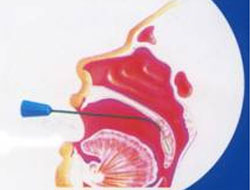
Pharyngeal reflex is a contraction of the back of the throat triggered by an object touching the roof of your mouth, the back of your tongue, the area around your tonsils, or the back of your throat. The reflex helps prevent choking, as well as helping to moderate the transition from liquid to solid foods during infancy.
By thrusting objects in the throat toward the opening of the mouth, the gag reflex expels substances that the brain has deemed harmful. In the first few months of a baby's life, this reflex is triggered by any food that a region of the brain stem called the "nucleus tractus solitaries" judges to be too chunky for a baby's stomach to digest. Starting around the 6- or 7-month mark in babies, the gag reflex diminishes, allowing a baby to swallow chunky or solid foods.
The disease pertains to the category of "Manhoubi" (chronic inflammation of throat) in TCM. Due to asthenia of the lung and kidney, the deficient body fluid will cause asthenic fire to flare up, scorching the pharyngolarynx and resulting in the disease. This is the way most chronic pharyngitis occurs. Because of this, the disease is also called "Xuhuo Houbi" (inflammation of throat due to asthenic fire).
 Pharyngeal reflex is a contraction of the back of the throat triggered by an object touching the roof of your mouth, the back of your tongue, the area around your tonsils, or the back of your throat. The reflex helps prevent choking, as well as helping to moderate the transition from liquid to solid foods during infancy.
Pharyngeal reflex is a contraction of the back of the throat triggered by an object touching the roof of your mouth, the back of your tongue, the area around your tonsils, or the back of your throat. The reflex helps prevent choking, as well as helping to moderate the transition from liquid to solid foods during infancy.